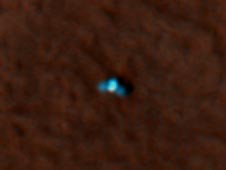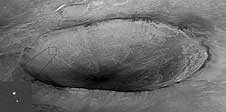|
Phoenix Lander Information |
|
Mars Information |
 |
| The butterfly-like object in this picture is NASA's Phoenix Mars Lander, as seen from above by NASA's Mars Reconnaissance Orbiter. [ more ] |
NASA Mars Lander Prepares to Move Arm
27 May 2008
NASA's Phoenix Lander is ready to begin moving its robotic arm, first unlatching its wrist and then flexing its elbow.Mission scientists are eager to move Phoenix's robotic arm, for that arm will deliver samples of icy terrain to their instruments made to study this unexplored Martian environment.
The team sent commands for moving the arm on Tuesday morning, May 27, to NASA's Mars Reconnaissance Orbiter for relay to Phoenix. However, the orbiter did not relay those commands to the lander, so arm movement and other activities are now planned for Wednesday. The orbiter's communication-relay system is in a standby mode. NASA's Mars Odyssey orbiter is available for relaying communications between Earth and Phoenix.
NASA's Mars Reconnaissance Orbiter did send back spectacular first images of the landed Phoenix from orbit, views from the Phoenix lander of where it will work for the next three months, and a preliminary weather report.
A newly processed image from the high-resolution camera known as HiRISE on NASA's Mars Reconnaissance Orbiter shows a full-resolution view of the Phoenix parachute and lander during its May 25 descent, with Heimdall crater in the background.
 |
| This is a view from Mars Reconnaissance Orbiter of the Phoenix parachute and lander during its May 25 descent, with Heimdall crater in the background. [ more ] |
HiRISE has taken a new color image of Phoenix on the ground about 22 hours after it landed. It shows the parachute attached to the back shell, the heat shield and the lander itself against red Mars. The parachute and lander are about 300 meters, roughly 1,000 feet, apart.
Commands to be sent to the lander Wednesday morning include taking more pictures of the surroundings and making the first movements of the mission's crucial robotic arm.
A covering that had shielded the arm from microbes during its last few months before launch had not fully retracted on landing day, May 25, but it moved farther from the arm during the following day.
"The biobarrier had relaxed more and allows more clearance, but it was not a major concern either way," said Fuk Li, manager of the Mars Exploration Program at NASA's Jet Propulsion Laboratory, Pasadena, Calif.
During the next three months, the arm will dig into soil near the lander and deliver samples of soil and ice to laboratory instruments on the lander deck. Following today's commands, its movements will begin with unlatching the wrist, then moving the arm upwards in a stair-step manner.
Phoenix principal investigator Peter Smith of the University of Arizona was delighted with new images of the workspace. "The workspace is ideal for us because it looks very diggable. We're very happy to see just a few rocks scattered in the digging area."
The Phoenix weather station, provided by the Canadian Space Agency, was activated within the first hour after landing on Mars, and measurements are now being recorded continuously. The data from the first 18 hours after landing have been transmitted back to the science team, and they have provided a weather report. The temperature ranged between a minimum of minus 80 degrees Celsius (minus 112 degrees Fahrenheit) in the early morning and a maximum of minus 30 degrees Celsius (minus 22 degrees Fahrenheit) in the afternoon. The average pressure was 8.55 millibars, which is less than a hundredth of the sea level pressure on Earth. The wind speed was 20 kilometers per hour (13 miles per hour), out of the northeast. The skies were clear. More instruments will be activated over the coming days, and the weather report will expand to include measurements of humidity and visibility.
Smith presented a new Surface Stereo Imager view of the American flag and a mini-DVD on the Phoenix's deck, about three feet above the Martian surface. The mini-DVD from the Planetary Society contains a message to future Martian explorers, science fiction stories and art inspired by the Red Planet, and the names of more than a quarter million Earthlings.